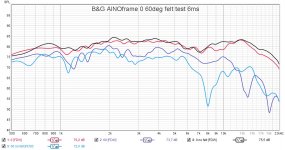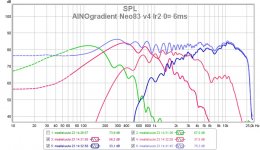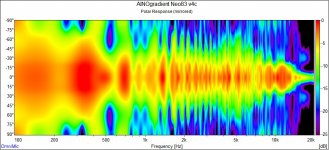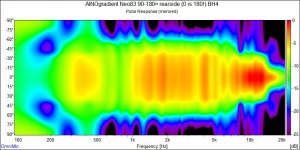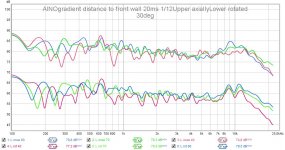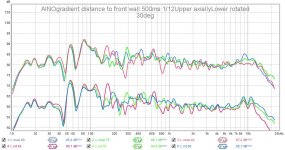If I look Bushmeisters OB polar measurements, there are visible dipole peaks at post The 'Circles of Doom'.....Open baffleless full range speakers.Why on tweeter responses no dipole peaks and minimums visible?
As my estimation lower tweeter first dipole peak is probably at about 3-4 kHz, first minimum at 6-8 kHz, on higher tweeter little higher, but for both no trace of peaks and minimums in polar plot. At dipole peak this kind of OB speakers (basically small U-frame OB) as are your tweeters, must have nearly omnidirectional polar response.
on 2.8 kHz and 8 kHz but Juhazi had avoided them on his bigger baffles.
Where is the magic?
I'm travelling, I can answer on Sunday. But I guess it's the minimal baffle and some smoothing. My avatar is normalized to on-axis.
Please go back some 5-6 years in this thread!
Please go back some 5-6 years in this thread!
If I look Bushmeisters OB polar measurements, there are visible dipole peaks at post The 'Circles of Doom'.....Open baffleless full range speakers.
on 2.8 kHz and 8 kHz but Juhazi had avoided them on his bigger baffles.
Where is the magic?
Every driver in any frame has dipole peak an null, and at null directivity is much wider than in dipole range. Above dipole null, directivity follows the same rules that a monopole driver has, determined by radiator width and frame width (narrowing towars higher freq.) "Ideal dipole patern" happens up to dipole null, so each driver must be lowpassed an octave below that (haf the frequency), so that directivity problems will be attenuated and compensated by the highpassed driver.
A planar driver has very symmetric directivity in both directions, but cone/coil driver's backside patern is pretty much disturbed by the spider and motor structure, specially abouve 2kHz.
When a planar driver is attached to a frame of some kind, it is important to make the frame as much acoustically transparent as possible. This means minimal thickness and smooth contour. Hanging with wires is best solution in this regard.
AINOgradient speaker has 8mm thick plywood frame for the upper mid and tweeter, which are planar units. Inner edges of the cutout are rounded with a file and drivers are attached on the backside. This means that actually backside response is smoother that frontal!
Attached a sim in Edge and several different non-normalized responses. After those polar measurements I have added felt pads to make tweeter's width narrower, which made response eve smoother, but I can't hear the difference.
Attachments
So, I've happily used B&O ICEpower 123 and 50 modules for some 8 years now. They have had power on for 24/7 and they run cool and nice. I get no noise, but all the sound quality and spl everyone wants and much more than I need. Still available and recommended! Just pay attention to signal levels.
Archimago just published test of 50ASX2, and Amir has tested 125ASX2
Archimago's Musings: MEASUREMENTS: S.M.S.L. A6 as amplifier [ICEpower 50ASX2(SE) Class D module]. (And DAC output - AKM AK4452 AMPT.)
ICEPower 125ASX2 Class D Amplifier Review | Audio Science Review (ASR) Forum
Minidsp 4x10HD was tested by Tom Christiansen
Review: MiniDSP 4x10HD – Neurochrome
Archimago just published test of 50ASX2, and Amir has tested 125ASX2
Archimago's Musings: MEASUREMENTS: S.M.S.L. A6 as amplifier [ICEpower 50ASX2(SE) Class D module]. (And DAC output - AKM AK4452 AMPT.)
ICEPower 125ASX2 Class D Amplifier Review | Audio Science Review (ASR) Forum
Minidsp 4x10HD was tested by Tom Christiansen
Review: MiniDSP 4x10HD – Neurochrome
I had holidays for 2½ weeks and because of covid and low outdoor temp spent lots of time listening to AINOgradients and Avalanches. They are in different rooms, so maturally they sound very different. One common feature is sealed box bass with dsp, so lowest bass has similar prescise adn solid nature. I made som "tuning" for both and tested a divider for the dipole Neo3 tweeter of AINOs.
Planar tweeter has always very narrow radiation above 10kHz, and Neo3 has on-axis dip around 8kHz. I tested what a divider might do, so I took scissors and an old mobile phone's wallet and butchered it to make a cross on the frontside. Sad to say change in response was minimal by measurements and I couldn't hear any difference. Measurements were taken at 40cm axially, indoors. One on-axis response is widely different, it obviously had a different mic location.
Then I connected minidsp to laptop and made some changes in subwoofer's lowpass/eq, because some male speech voices were too heavy. Bass response is always very difficult to eq because measurement techniques leave many questions, and heavy room effects. I make final choices by listening, when measurements start looking good. My listening spot and speaker locations have been the same for all the time (almost 9 years now), and 55Hz room mode is dominant. I have tried taming it, but then my ears don't like the sound at all. I don't use any other high Q peak corrections either for room response, for obvious reasons (multipoint measurements!) Despite of cardioid pattern, 200Hz range looks nasty too.
Planar tweeter has always very narrow radiation above 10kHz, and Neo3 has on-axis dip around 8kHz. I tested what a divider might do, so I took scissors and an old mobile phone's wallet and butchered it to make a cross on the frontside. Sad to say change in response was minimal by measurements and I couldn't hear any difference. Measurements were taken at 40cm axially, indoors. One on-axis response is widely different, it obviously had a different mic location.
Then I connected minidsp to laptop and made some changes in subwoofer's lowpass/eq, because some male speech voices were too heavy. Bass response is always very difficult to eq because measurement techniques leave many questions, and heavy room effects. I make final choices by listening, when measurements start looking good. My listening spot and speaker locations have been the same for all the time (almost 9 years now), and 55Hz room mode is dominant. I have tried taming it, but then my ears don't like the sound at all. I don't use any other high Q peak corrections either for room response, for obvious reasons (multipoint measurements!) Despite of cardioid pattern, 200Hz range looks nasty too.
Attachments
-
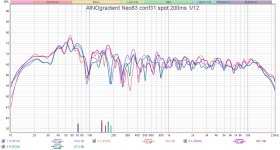 ainogneo83 conf 31 spot LR 200ms 112.jpg268.5 KB · Views: 238
ainogneo83 conf 31 spot LR 200ms 112.jpg268.5 KB · Views: 238 -
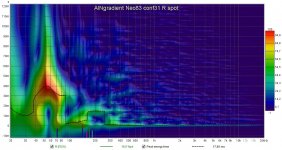 ainogneo83 conf31 R spot wavelet.jpg168.9 KB · Views: 364
ainogneo83 conf31 R spot wavelet.jpg168.9 KB · Views: 364 -
 neo3 divider test.jpg497.7 KB · Views: 348
neo3 divider test.jpg497.7 KB · Views: 348 -
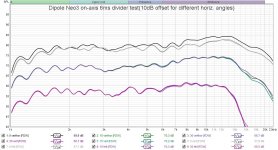 neo3 divider test onaxis 6ms 124.jpg183.4 KB · Views: 346
neo3 divider test onaxis 6ms 124.jpg183.4 KB · Views: 346 -
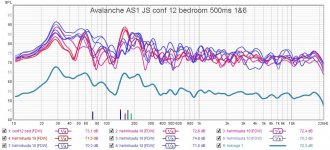 as1js conf 12 bedroom ave 500ms 16.jpg172.3 KB · Views: 246
as1js conf 12 bedroom ave 500ms 16.jpg172.3 KB · Views: 246 -
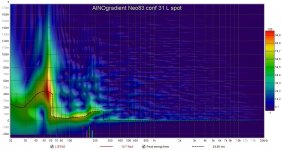 ainogneo83 cong31 L spot wavelet.jpg163.2 KB · Views: 239
ainogneo83 cong31 L spot wavelet.jpg163.2 KB · Views: 239
Juhazi,
What are your thoughts about the band where the radiation is cardioid in your system. Specifically, what do you think (now that you have lived with it, etc.) is the best target band for cardioid radiation?
I am thinking about building a dipole on top of a small upward facing closed box subwoofer and I would like to plan the overlap region, and thus the requirements for the dipole driver. I would like to keep the footprint small, but this would require the dipole driver to also be small (e.g. 10" or less) and 100Hz dipole SPL capability might be too limited and the lower edge of the cardioid pattern might have to be higher. I am not sure that would be useful/helpful.
Sorry Charllie, I have missed your question.
It is difficult to answer your question, because AINOs have been at same location all the time and since then I haven't had other "normal" speakers at same location either. Main advantage of cardioid is reduced front-wall first reclection, which depends on distance. Anyway, seems like I have problems around 200Hz despite the cardioid pattern is just there. Speaker distance to wall is roughly 50cm and they are turned 30deg in.
Attached measurements of the test I made after reading your post. Mic location was fixed, at roughly 1,5m.
Attachments
https://www.alvaraalto.fi/en/news/t...lebration-of-finnish-architecture-and-design/
Finnish Architecture and Design Days aim to open our eyes to the architecture and design that surrounds us in our daily lives. Building knowledge of our built environment reinforces ownership and inclusion.
Since 2012, Finnish architecture has been celebrated on February 3rd, the birthday of architect and designer Alvar Aalto (1898–1976). Last February, the event was piloted as a shared celebration of architecture and design, when eleven organisations of the fields put forward a motion to establish the day as a national flag-flying day. The motion is being processed at the Finnish Ministry of the Interior.
https://www.alvaraalto.fi/en/information/aino-aalto/

My home town Jyväskylä was Alvar Aalto's school town and he had his first office here We still have almost 30 houses designed by him, including his summer house. The Aalto museum is dedicated to his and his both wifes' work https://visit.alvaraalto.fi/en/destinations/alvar-aalto-museum/
Finnish Architecture and Design Days aim to open our eyes to the architecture and design that surrounds us in our daily lives. Building knowledge of our built environment reinforces ownership and inclusion.
Since 2012, Finnish architecture has been celebrated on February 3rd, the birthday of architect and designer Alvar Aalto (1898–1976). Last February, the event was piloted as a shared celebration of architecture and design, when eleven organisations of the fields put forward a motion to establish the day as a national flag-flying day. The motion is being processed at the Finnish Ministry of the Interior.
https://www.alvaraalto.fi/en/information/aino-aalto/
My home town Jyväskylä was Alvar Aalto's school town and he had his first office here We still have almost 30 houses designed by him, including his summer house. The Aalto museum is dedicated to his and his both wifes' work https://visit.alvaraalto.fi/en/destinations/alvar-aalto-museum/
Last edited:
Hi @Juhazi, I have read a fair bit of this thread, I stumbled upon it googling NEO8 as I have bought NEO8 and NEO3 both PDR to build an open baffle. My current speakers are LXmini+2 with dipole subwoofer, not a great speaker with original EQ but now very good with modifications to XO qnd EQ.
Your measurements show great promise for the NEO drivers, I have 2 JBL 2251JPL mid/woofers that I plan to pair with the NEO's. Subwoofer will remain the Seas L26ROY
Thanks for documenting your journey.
Your measurements show great promise for the NEO drivers, I have 2 JBL 2251JPL mid/woofers that I plan to pair with the NEO's. Subwoofer will remain the Seas L26ROY
Thanks for documenting your journey.
Your plan sounds very good!Hi @Juhazi, I have read a fair bit of this thread, I stumbled upon it googling NEO8 as I have bought NEO8 and NEO3 both PDR to build an open baffle. My current speakers are LXmini+2 with dipole subwoofer, not a great speaker with original EQ but now very good with modifications to XO qnd EQ.
Your measurements show great promise for the NEO drivers, I have 2 JBL 2251JPL mid/woofers that I plan to pair with the NEO's. Subwoofer will remain the Seas L26ROY
Thanks for documenting your journey.
I've read through these VCLLabs 3- and 4-way dipole project pages earlier, but perhaps didn't link them here. Here you can get nice and systematic presentation how design and setup process with dsp goes. Almost precisely as I did by try-fail-correct method... This project doesn't include driver selection and optimization however... but it is just a proto to show the system approach.
https://vcllabs.com/project04/#chapter5

https://vcllabs.com/vcl-ex21/

http://vcllabs.com/vcl-ex22/

https://vcllabs.com/project04/#chapter5
https://vcllabs.com/vcl-ex21/
http://vcllabs.com/vcl-ex22/
Last edited:
Updated AINOgradient presentation, corrected typos and updated measurements
https://drive.google.com/file/d/1oYIIwYCYkIvvOfLuNnEgOpodKrd3kOkG/view?usp=sharing
https://drive.google.com/file/d/1oYIIwYCYkIvvOfLuNnEgOpodKrd3kOkG/view?usp=sharing
So, looks like my Minidsp 4x10HD is sick, after 9 years. It started to send 6 and 8kHz noise to speakers last week, and now after I disconnected the power to check RCA connections, it doesn't start anymore, but puts outboard power supply to safety mode (shutdown). I tried two 12V power units several times.
I don't know anything about electronics, so I must disconnect the unit and take it to the local tv/audio repairman. Production of these is finished and FLEX 8 takes in only digital signal, which means that me and the family should use two remotes to adjust spl... My preamp is Yamaha RX-V 685 that has analog out for main stereo channels which follow it's volume settting. Minidsp HD models with analog in give transparence of the active speakers, which have power on 24/7 like the dsp(s).
Meanwhile, I guess I must use my two unused 2x4HD units to do the work of 4x10HD. That means transforming dsp settings, I must wait for the next weekend which should be rainy. If repair shop raises hands, I must search for a second hand 4x10HD.
I don't know anything about electronics, so I must disconnect the unit and take it to the local tv/audio repairman. Production of these is finished and FLEX 8 takes in only digital signal, which means that me and the family should use two remotes to adjust spl... My preamp is Yamaha RX-V 685 that has analog out for main stereo channels which follow it's volume settting. Minidsp HD models with analog in give transparence of the active speakers, which have power on 24/7 like the dsp(s).
Meanwhile, I guess I must use my two unused 2x4HD units to do the work of 4x10HD. That means transforming dsp settings, I must wait for the next weekend which should be rainy. If repair shop raises hands, I must search for a second hand 4x10HD.
Hmm, looks like this box could replace 4x10HD https://www.minidsp.com/products/car-audio-dsp/c-dsp-8x12
Certainly a more powerful DSP unit. I hadn’t actually enquired with MiniDSP whether it is pros and cons for the 410 HD. Looks technically superior but I liked the jog dial / button/display & remote control of the 410HD
I use dial or remote only at hardcore tweaking sessions, which are over now. I recently had a mild stroke and was diagnosed epilepsy - and lost interest in new projects.
Sorry to hear that Juhazi.I recently had a mild stroke and was diagnosed epilepsy
Take care of your health..
A friend of mine uses a MiniDSP 8x12 in his main system. It's modified so he's not using the analog I/O. I2S has been tapped into and sends SPDIF to an external Lucid mutli channel DAC.
The Flex 8 certainly looks better than the 4x10HD. I sold my 4x10HD a couple of months ago and bought one of these. It spanks the MiniDSP.
https://analog-precision.com/
Sorry to hear you have had heath issues.
The Flex 8 certainly looks better than the 4x10HD. I sold my 4x10HD a couple of months ago and bought one of these. It spanks the MiniDSP.
https://analog-precision.com/
Sorry to hear you have had heath issues.
- Home
- Loudspeakers
- Multi-Way
- Aino gradient - a collaborative speaker project

